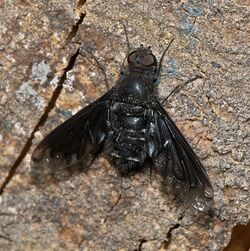Biology:Anthrax anthrax
| Anthrax anthrax | |
|---|---|

| |
| Scientific classification | |
| Domain: | Eukaryota |
| Kingdom: | Animalia |
| Phylum: | Arthropoda |
| Class: | Insecta |
| Order: | Diptera |
| Family: | Bombyliidae |
| Subfamily: | Anthracinae |
| Tribe: | Anthracini |
| Genus: | Anthrax |
| Species: | A. anthrax
|
| Binomial name | |
| Anthrax anthrax | |
| Synonyms | |
Anthrax anthrax is a species of fly in the family Bombyliidae. Unlike, for example, Bombylius major, this species does not mimic a bee. The eggs are flicked by the adult female toward the entrance of the nests of mason bees. After hatching, the larvae find their way into the nests to feed on the bee larva. A. can be found in May to August throughout mainland Europe.[2] In the Netherlands A. anthrax is a common visitor of insect hotels.[3] It was first recorded as breeding in Britain in 2019.[4]
Description
A. anthrax is a fairly large fly, the body length is 10 mm. The body is black with four white markings at tergum 2 and 3 and two white markings at the end of the abdomen. Tergum 1 is black with tufts of white hairs at the side. These tufts are visible in this picture of a hovering fly. The wings are mostly black, only the top is transparent. The veins are dark brown. The following picture was overexposed. Due to the brightly lit background the veins are visible. The newly emerged Anthrax anthrax may be found sitting on a bee hotel. Their body is dull black with more transparent wings.
The veins are visible due to the bright background
Behaviour
The females may be found hovering before an insect hotel shooting eggs into the nest entrances of mason bees.[5] Occasionally females rub their abdomen with dust or sand. Dust or sand is necessary to make the eggs less tacky. To this end the females have a 'sand chamber'.[6] A. anthrax is sometimes seen hovering above a flower.
Distribution
Afghanistan, Albania, Algeria, Armenia, Austria, Azerbaijan, Belarus , Belgium, Bulgaria, Canary Islands, China , Czech Republic, Denmark , Estonia, Finland , France , Germany , Greece, Georgia, Hungary, Iran, Italy, Serbia.
References
- ↑ 1.0 1.1 Schrank, F. von Paula (1781). Envmeratio insectorvm Avstriae indigenorum. Augustae Vindelicorum [=Augsburg]: Eberhardi Klett et Franck. pp. xxiv + 548 + [4] pp., 4 pls. https://www.biodiversitylibrary.org/item/51804#page/7/mode/1up. Retrieved 27 April 2021.
- ↑ Stubbs, A.; Drake, M. (2014). British Soldierflies and Their Allies: A Field Guide to the Larger British Brachycera. British Entomological & Natural History Society. pp. 528.
- ↑ Breugel, P. van 2014. Gasten van bijenhotels. – EIS Kenniscentrum Insecten en andere ongewervelden & Naturalis Biodiversity Center, Leiden.
- ↑ Woods, M. J (2020). "First records of breeding of the bee-fly Anthrax anthrax (Schrank) (Diptera, Bombyliidae) in Britain in 2018/2019, demonstrated by observations near Canterbury, Kent in 2019". Dipterists Digest 27 (1): 53–59.
- ↑ Wijngaard, W. (2012). "Control of hovering flight during oviposition by two species of Bombyliidae". Proceedings of the Netherlands Entomological Society Meeting 23: 9–20.
- ↑ Yeates, D.K. (1994). "The cladistics and classification of the Bombyliidae (Diptera : Asiloidea)". Bulletin of the American Museum of Natural History 219.
Wikidata ☰ Q574344 entry
 |





